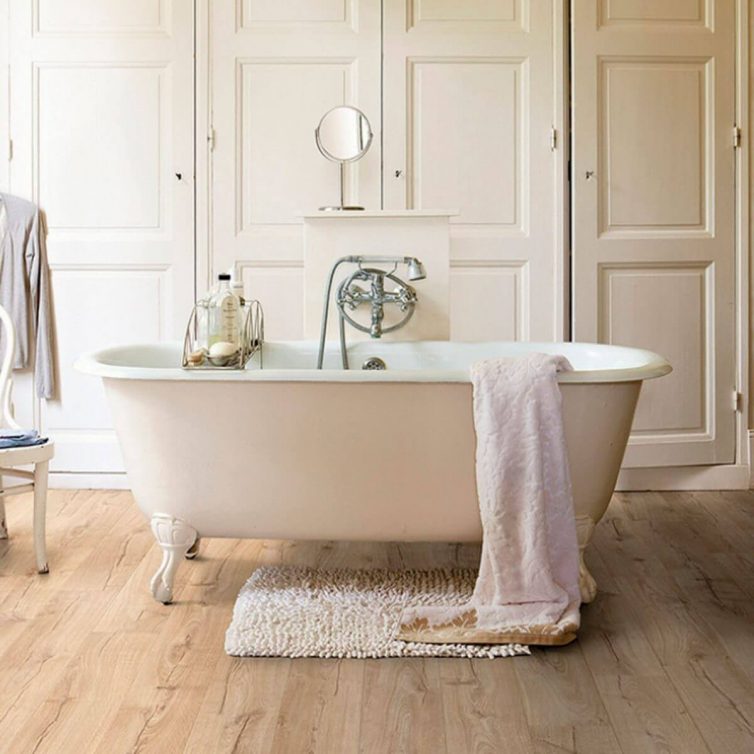People confuse laminate and engineered flooring quite often because they are similar in both the price, as well as the installation method.
In reality, they couldn’t be more different. While each of them has its own good and bad sides, it’s akin to comparing apples and oranges.
In case you are wondering whether to go one way or the other, this article may be just the thing you need to make the right decision.
Let’s take a detailed look at both engineered and laminate flooring and see what they are all about!
Engineered Floor Explained
There is a common misconception that engineered flooring is not made of hardwood. This is a rather controversial subject. Engineered wood is created from three wood layers glued together – base, core, and veneer.
The veneer is always a real, natural wood with a thickness from 2 – 6 mm while the base and core are ply boards. It’s up to you to decide if ply wood is real enough.
What exactly is Laminate flooring?
Laminate is created from four parts. The base is formed from a paper or melamine sheet with a high-density fibreboard (HDF) in the core, and the printed image of certain material (wood in our case) on the very top.
All of this is sealed under a protective layer of said melamine. Laminate floors are made from natural materials (wood fibres) but they are created artificially and because of this laminate is more on the synthetic side of things.
Engineered and Laminate Comparison
Cost: Engineered floors are considered as a valid alternative to the more valuable, and therefore expensive, solid wood flooring. The difference in price, however, isn’t that big. Engineered floors are more expensive than most laminates.
Laminate is actually one of the cheapest alternatives on the market, but the quality is can be bad. Certain products, such as Quick-Step’s diversified ranges, offer prices comparable to engineered floors for their products, and you get your money’s worth out of them.
Resale value: In the last few years, engineered floors have become more desirable as a whole. Even if they are still not on par with solid wood, their resale value is good. Laminate, on the other hand, is less expensive so its worth isn’t as great, despite the fact it’s becoming more popular.
Moisture resistance: Engineered is the least moisture sensitive type of wood flooring on the market. Warping, cupping, and bowing shouldn’t be a problem. Water resistance is its biggest strength compared to solid wood, but it can’t match a laminate.
You see, a good laminate floor is very resistant to water, as long as its coating holds. Once that protection is penetrated, though, the floor will be completely ruined. There are even certain laminates specifically designed for bathrooms but some people claim that there isn’t much of a difference if you compare bathroom specific product and a regular laminate. It’s more about a personal taste.
Durability: A laminate will be harder to damage or dent. If a laminate has a sufficient quality, it will also hold better against sunlight without going yellow. It is definitely the better choice for high traffic areas. On the other hand, engineered floors can be sanded and refinished.
Lifespan: As mentioned above, engineered floors can be refinished, but the amount of times depends on their relatively thin veneer. The more expensive engineered floors have much thicker wear layer – up to .25″. You will be able to refinish them a few times, but the longevity of solid wood is unparalleled and it is definitely the better long term investment. In comparison, a laminate can never be refinished, which makes it more of a short term flooring. Generally, an engineered floor can last for around 75 years at most, while the laminate’s lifespan will rarely go over 20.
Installation: Maybe you have heard the terms “above or below” grade. This means that a certain floor can be installed above or below ground level. Basement, for example. Both laminate and engineered floors can be installed pretty much anywhere.
The Best and Worst About Laminate and Engineered Flooring
No matter what, engineered floors have one redeeming quality which puts them above laminates – The fact that they are made from real, natural wood! Despite this, you may want to consider it can only be refinished a few times. If that is so, why not simply go for solid wood?
Laminates have a very strong wear layer and are very resistant to scratching. They, however, can never be refinished. It is possible to do spot repairs from time to time, but if the things get serious -replacement is the only option.
